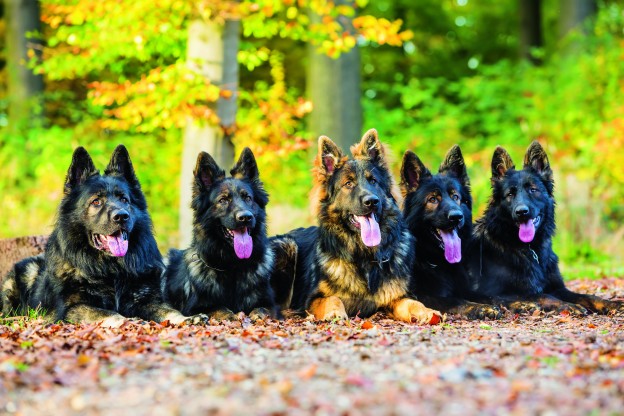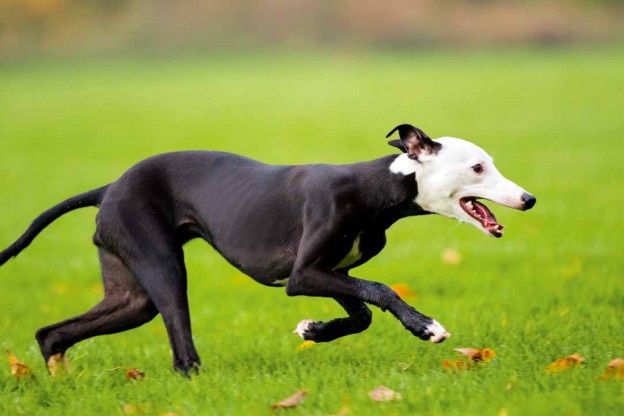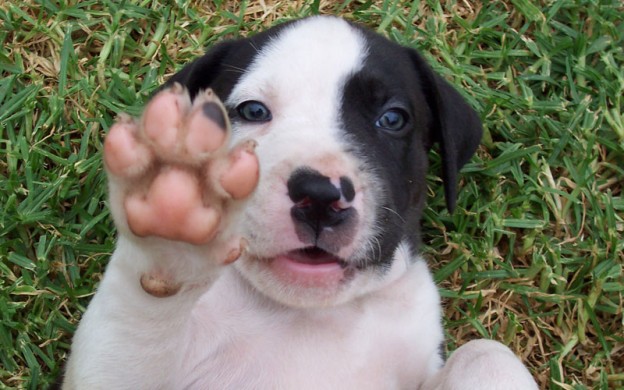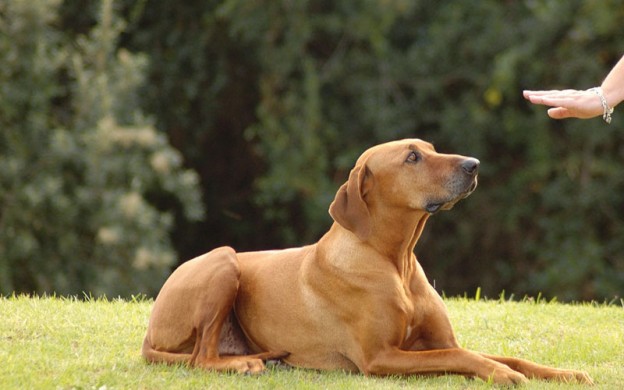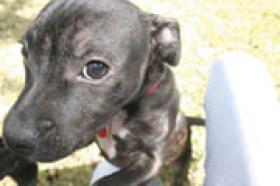
Caroline Zambrano found solutions to some common behavioural problems in canines with top dog trainer Steve Austin and teaches you some ways in solving bad dog habits.
An animal trainer for more than 25 years, Steve Austin is also the National Detector Dog Trainer for the Australian Quarantine Inspection Service (AQIS) and he knows all about canine behaviour problems. Dogs Life met up with Austin at Sydney’s Hanrob Pet Care Centre to find out how to solve the most common behavioural problems in dogs.
The top behavioural problems are barking, separation anxiety, poor socialisation, pulling on the lead, not coming when called, aggression, shyness, jumping up on people and poor backyard behaviour. Solving these problems boils down to exercise, according to Austin, who is now owner and director of Pet Lands Australia, Dural branch.
Understanding the importance of exercise
The one thing that will help solve all these problems is making sure your dog is well exercised, stressed Austin. The dog will be tired and physically exhausted so that it doesn’t want to jump up, doesn’t want to dig holes and doesn’t want to bark at night. I think a lot of people don’t realise how important exercise is for a dog.
Exercise helps to solve behavioural problems because when a dog is exercised, he gets a high amount of stimulus and becomes content and happy within himself. Therefore, the dog doesn’t stress out on things that normal dogs or people regard as unimportant. Exercise is not just playing in the backyard with your dog. It goes hand-in-hand with the stimulus interaction you get outside.
The dog can dig, smell, see, feel and become a lot more at ease within itself, Austin said.
Barking
Barking sneaks up on people, Austin said. It starts with bark bark every hour, then its bark bark bark bark bark every half an hour, then it goes on and on.
With a dog, I don’t think there is a grey area. Its black or white. So either you’re going to allow the dog to bark or not allow the dog to bark. If you (or your neighbours) have had enough of barking, then you must be diligent and not let your dog bark. You have to stop dogs barking at a very early age, Austin added.
To train your dog to stop barking, Austin suggested to first go out and take a look at whats going on is anyone coming around the fence or is there a possum? I say to the dogs, good dog, quiet. And if he continues after quiet then he gets punished with the naughty corner, he said. With repetition dogs learn that if they continue barking after quiet, they are going to get the naughty corner, which can mean getting locked in the laundry, put on a short chain for 10 minutes or sprayed with water spray.
In addition to consistent training, Austin urged owners to get their dog outside for a good workout. Let your dog get physically tired and mentally stimulated by getting outside and seeing everything happening. So when he gets back into the yard he is a lot happier physically and mentally because hes exhausted, he said.
Once you start and you are consistent with that, plus giving your dog plenty of exercise, you’ll see an improvement.
Separation anxiety
Separation anxiety occurs because the dog is spoiled and never left alone to develop its own personalities, Austin says.
If a dog is mollycoddled and picked up all the time, that is what it will learn as a young puppy, he said. I say in my puppy classes, don’t pick them up because up here is a different view to the one down there. Let the dog become strong and self supportive. The way to prevent dogs from getting separation anxiety is to give them time by themselves, starting at a very early age.
Two to three minutes a day, put them on a small chain and leave them by themselves to build up their mental strength, he said. Austin also suggests that when you come home, you shouldn’t automatically go to your dog; let him stay outside or ignore him for 10 minutes so he can develop mental strength.
Dogs get anxious because they don’t know any other way, he claims. Get them to learn that being alone is normal. Being by themselves as well as with you is normal, he says.
If your dog has separation anxiety, you have to reverse that by putting your dog out alone for short periods of time to become strong mentally. Develop 10 to 15 minutes each day over a long period of time, and increase the periods of time apart. You will find that the problem will slip away, Austin says. Never, never, never go to your dog when hes showing anxiety, when hes barking, upset or trying to get inside to you.
That’s the only time you ignore him, he said. As soon as hes calm and quiet, then you let him inside. And he learns that calm, quiet behaviour gets rewarded, while barking, scratching and stressful behaviour gets ignored. Separation anxiety occurs mostly in small breeds, with littermates or when people buy two dogs together in a short amount of time, Austin said.
I have four dogs at home and each one of those dogs would rather be with me than any of the other dogs. And that’s because I spend a lot of time with each individual dog. You must make sure you are the highlight of that dogs life, he said. You have to be careful when dogs become so close that they ignore you. Austin urged to develop their individual strengths to learn to be apart from each other.
Leave one dog at home and take the other dog out for a walk. People say its cruel, but its more cruel when one dog dies and the other dog freaks out completely, he said.
Aggression/biting
Dogs can be aggressive towards other dogs and/or people. Austin shared some great tips on how to get your canine to cool down around two-legged and four-legged mates:
For about one month, don’t give your dog any food except from your food pouch around your waist. When you take your dog to the park with other dogs, keep him on a lead all the time. When your dog sees another dog, call his name Bobby come sit and as a reward, you give him a portion of his days normal income of food from your food pouch.
Repeat this as many times as you possibly can. So all the food he is getting during that day or that afternoon is earned by looking at a dog and then turning around and sitting and looking at you to get his food, Austin explained. By using your dogs normal income of food for the day as treats, you will automatically turn the potentially aggressive situation from a negative scenario to a positive scenario.
He gets exactly the same amount of food, but he has to earn it by being a good boy. Its a great way of turning a very aggressive dog into a well-behaved dog very quickly, he said. You can also do this exercise without food by using a tennis ball, tug toy, whatever your pooch likes to play with.
For more information about using praise and treats to train your dog, check out Naturally Healthy Training Your Pooch With Praise & Treats, on page 24.
Human aggression
Sometimes a dog becomes aggressive towards the owner or other people and Austin says this is mainly because the owner doesn’t show enough leadership in the relationship. If a dog is aggressive (towards his owner), nine times out of 10 the owner of the dog is weak and the dog says you are not my leader, I feel insecure around you, I have to take the leadership role, Austin said.
A leader doesn’t hurt the dog, doesn’t scream at the dog and doesn’t hit the dog, he said. The leader is a person who the dog feels very safe and secure around so when the dog has a strong leader, he is very rarely aggressive, Austin said. I see this with many young girls 19- to 20-year-olds, who get these Malamute puppies fluffy, cute and they grow up and take over.
If you feel you are in a dangerous situation and you are worried about your safety, you can train your dog to accept you as leader, Austin said:
- Put a bowl in front of your dog.
- You put a tiny bit of food in the bowl and you say you may eat and allow your dog to eat.
- If your dog is aggressive towards other people, have the person put the food in the bowl and give your dog permission to eat. You must have your dog on a lead when other people come to feed.
- This action says to the dog that people coming to him are good and the owner telling him when to eat elevates the owner.
Don’t let him eat, get in the car or cross the road until hes told. Elevate yourself, Austin advised.
Pulling on lead
Dogs pull on the lead because experience has shown them that it is beneficial to them or so they believe! Look at it from the dogs point of view, Austin said. They pull in the direction they want to go and you follow them there. How do you stop your dog from pulling on the lead? Think about it in terms of consequence of behaviour, he answered.
The dog wants to move quickly in a particular direction. Pulling on the lead must now result in failure to move quickly in that direction. The owner can come to a complete stop or, alternatively, abruptly change directions. Yes, it will take a long time to get to the shop to buy that carton of milk, he said, laughing.
But to progress things a little more quickly, consider the use of a training aid, such as a head-halter or easy-walker harness (not the type used to strap dogs in the car). Such devices place more control in the owners hands and reduce the dogs strength advantage, Austin said.
Fear and shyness
Same as with a dog that is aggressive, dogs with fear and shyness don’t feel secure in their surroundings. Its about getting the dogs confidence up, Austin said. A lot of fear and shyness is genetic. If its environmental because someone has abused the dog, then what you have to do is get the dog to trust you again. Some tips to help your dog battle fear and shyness:
- Give the dog to different people.
- Ask others to feed your dog.
- Take your dog out and about.
- Do not reward any fear or shy behaviour. Ignore fearful or shy behaviour and
- only praise and reward outgoing and happy behaviour.
- Get other people to give your dog as many nice experiences as possible.
Poor socialisation
According to Austin, poor socialisation is the number one reason why many dogs end up in the pound. He recommended socialising your puppy at as many places as possible, starting from eight to 10 weeks of age.
Make sure he sees the big bad world at a very early age, he said. You have to be realistic; you can’t take them to a dog park at a very young age, but you can take them to shopping centres, friends houses, so your puppy becomes really outgoing.
By 12 weeks he has seen it all and doesn’t worry about things as much. What do you do if you got a dog from the pound that has been poorly socialised, Dogs Life asked? Socialising efforts during the critical developmental phase (three to 12 weeks of age) are certainly easier and more likely to result in permanent, life-long learning benefits, he said.
However, older dogs can benefit from new and progressively more difficult social situations. Austin says, as always, to avoid allowing your dog to practise the wrong behaviour and instead, set your dog up to learn and practise the correct behaviour.
Place your dog in a controlled social situation that is mildly stressful for your dog, but where it can still cope, ensuring that the experience is rewarding (food treats, toys, attention etc). This may mean having the person or other dog remain at a distance; avert eye contact; hold a side-on position; crouch down.
You would do whatever it takes to make the dog feel relatively comfortable and then increase the degree of difficulty from that point. Only progress at the dogs comfort pace, ensuring the set-up social situation is rewarding. Never allow a person or another dog to force itself on your socially inexperienced dog.
Instead, allow your dog to move away from the situation without being pursued, Austin said. Alternatively, move your dog away, particularly if your dog is likely to react inappropriately. Again, your dogs daily food intake could be apportioned to social events only, he added.
Gaining and improving social skills for your mature dog can be a long and arduous journey, but incredibly rewarding when you can see your dogs ability in social situations improving and its stress levels reducing.
Jumping up on people
Jumping up is a normal behaviour and the only way to stop your dog from jumping is to teach him not to do so. The most common reason why dogs jump is to gain attention, Austin said. It is important to not encourage this behaviour by patting your dog when he jumps, he added. Train your dog to sit and reward, and get other people to tell your dog to sit and reward, he said.
Austin advised against lifting the knee as you can hurt your dog (crack a rib). He said it is more effective to train your dog to sit and get a reward.
Coming when called
It is a common sight to see a dog owner running across the park, arms waving madly and yelling at the top of their voice, Riiiiileeeey! Austin says the answer to getting your dog to come when he is called lies right inside your food pouch. Here are some tips to train your dog to come:
- Carry a food pouch with some yummy treats around your waist. (You can also use a portion of the normal food intake your dog gets for the day.)
- Take your dog out to a paddock on a long lead (10 metres).
Say the word once, Riley come, and pull the lead in gently. - When he comes to you give a treat to reward.
- Repeat this exercise 20 times for eight to 10 days. Your dog will learn with reward and repetition.
Poor backyard behaviour
Boredom and lack of exercise contribute greatly to poor backyard behaviour, Austin said. A bored and lonely dog can easily become a destructive dog, so it is important to give your dog plenty of exercise and stimulation outside of the yard and plenty to do in the backyard with lots of toys and distractions, he added.
Austin shared some tips for backyard fun:
- Freeze bones and food in an ice-cream container so they get a big ice block.
- Fill treat balls with treats so they have to play with it to get the treats out.
- Instead of wasting an opportunity for stimulation by giving the dog a bowl of food each day, have the dog hunt or scavenge for his daily food intake. If the dog is not inclined to dig, you can scatter the biscuits over a grassy area. For diggers, scatter the biscuits over a paved area. The dog will spend much time and attention finding every last biscuit and he will never be certain the last one has been found.
- Replace a regular meal of biscuits, with raw, meaty bones. Have the butcher chop them up into many small pieces and hide them around the yard. Alternatively, hang one large bone by a rope, at about the dogs head level. It will take more effort and time to consume the bone in this way.
Does your dog know sit?
Does your dog know the word sit? Dog trainer Steve Austin has a great way to find out! Turn around, face away from your dog and tell him to sit, and see if it does. Do it now! Did your dog sit? You can try the same technique to see if your dog knows what come means.
Top behavioural problems in canines:
- Barking
- Separation anxiety
- Poor socialisation
- Pulling on the lead
- Not coming when called
- Aggression
- Shyness
- Jumping up on people
- Poor backyard behaviour



